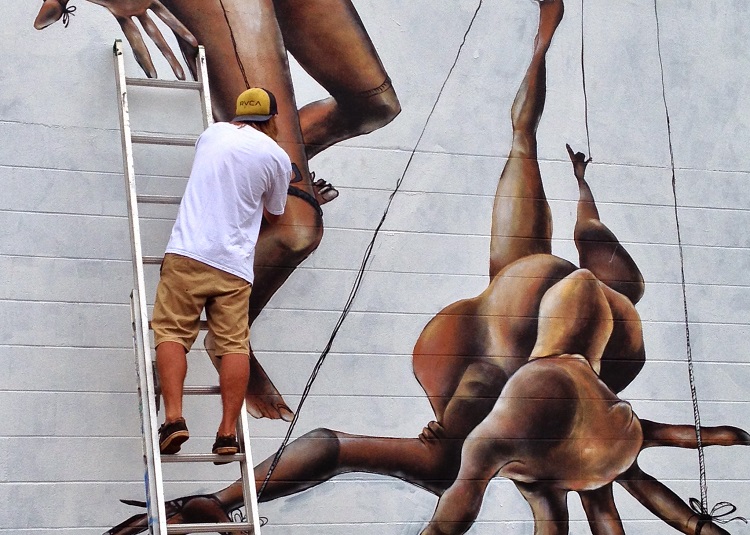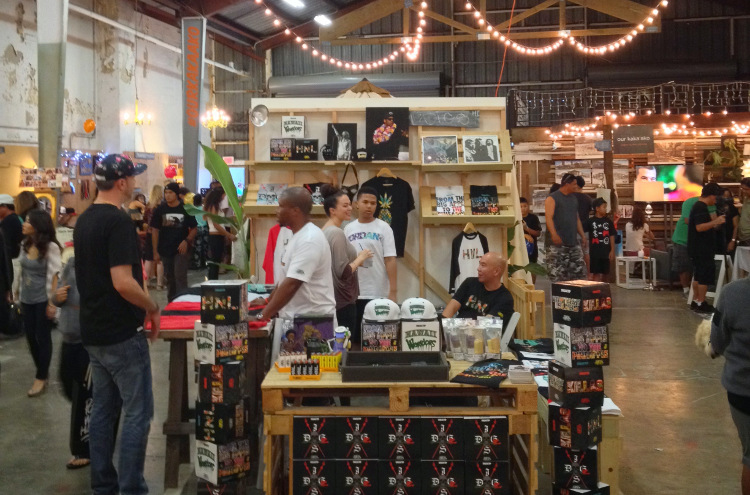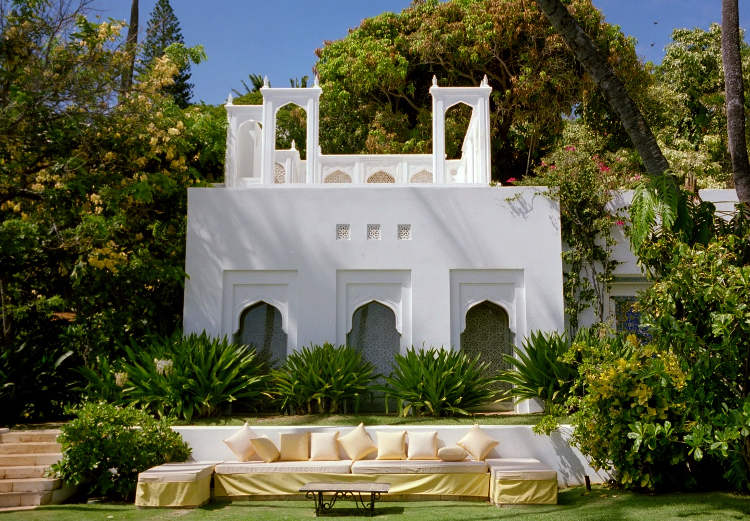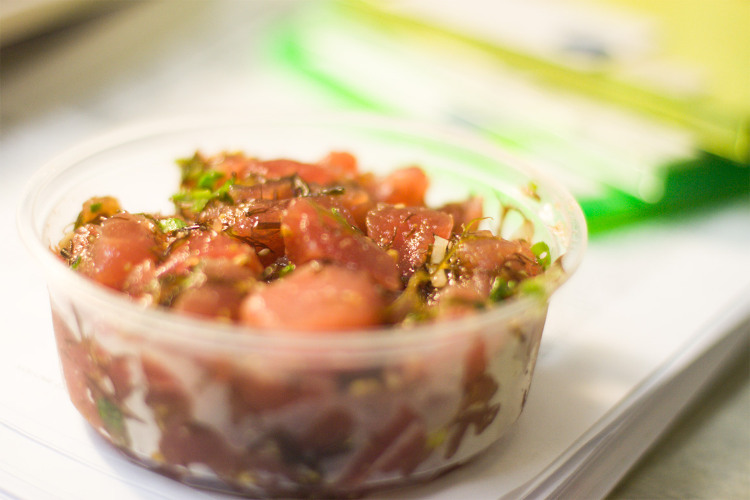
Mural being created for the Pow Wow Hawaii festival. Image by Tim Richards / Lonely Planet
Kaka’ako isn’t actually that hidden, situated as it is between Waikiki and Honolulu’s downtown. But visitors rarely give it a second glance, breezing by on their way from the airport. A historically industrial district on a stretch of flat land, it might seem an unlikely place to hang. Over the past few years, however, Kaka’ako has developed into Honolulu’s coolest ‘hood.
Each February it hosts the Pow Wow Hawaii festival, a celebration of street art that invites top artists from around the world to paint the area’s walls with huge colorful murals. These vast paintings are left in place until the following year, so there’s always something to look at. It’s great fun to track them down, camera in hand, to assemble your own street art collection – and they make fantastic photos to share online. For best results, start from the corner of Auahi and Cooke Streets and head northwest along Auahi, making sure to duck into Lana Lane as you reach it on the left. This laneway is home to the Lana Lane Studios (327 Lana Lane), the hub of artistic activity in Kaka’ako. It’s not usually open to the public, but you may well see its members at work on the surrounding walls.
There are plenty of good refreshment options near this stretch. For hip street food drop into Hank’s Haute Dogs , for locally-brewed beer check out Honolulu Beerworks , and for cutting-edge bar food and great cocktails visit Bevy .
For more murals and a dose of pre-gentrification Kaka’ako, walk along Queen Street between Ward Avenue and Cooke Street (being careful to avoid traffic on the section without sidewalks). In addition to spotting murals on the walls of automotive workshops, you’ll find Fresh Café , a trendy hang-out and the original home of Pow Wow Hawaii.
Another local highlight is the weekly Kaka’ako Farmers’ Market , featuring fresh Hawaiian produce. And once a month, the Honolulu Night Market takes over Auahi Street, creating the vibe of a big street party with stalls selling locally produced food, art and fashion. It doesn’t get less touristy than this.

Honolulu Night Market. Image by Tim Richards / Lonely Planet
The Honolulu Museum of Art is rightly praised for its impressive collection housed in its main building, not far from Waikiki. Lesser known, however, are two of its other premises on the edge of the city.
The first, Spalding House, is situated above the concrete sprawl in attractive Makiki Heights. This former home is now a small but impressive museum of contemporary art, with changing exhibitions often featuring local artists. There’s also a separate pavilion which houses a permanent installation by artist David Hockney, an interpretation of his stage designs for a 1981 opera. As fascinating as the art is, the extensive gardens almost surpass it with their sloping lawns and gullies, dotted with tropical plants and trees. On a sunny day you could spend hours here, looking at art then relaxing amid the greenery.

Exterior of Shangri La, Honolulu.
Image by Thomas Tunsch / CC BY-SA 2.0
The other hidden museum is Shangri La, located on the eastern side of Diamond Head in the upmarket Black Point neighborhood. This magnificent house once belonged to Doris Duke, a wealthy heiress who traveled the world and fell in love with Islamic art. She filled her Hawaiian home with pieces bought and commissioned in the Middle East, specifically from Iran, Egypt, Morocco, Turkey, and Syria. The result is a stunning tribute to Islamic artwork: the building is crammed with beautiful décor both old and new, including such rare items as 13th-century Persian tiles. The exterior is just as stunning, with a garden overlooking the Pacific and a former guest house in which Duke once hosted stars such as Elton John. Shangri La can only be visited on a bus tour from the Honolulu Museum of Art. It’s well worth it.

Tuna poke, a Hawaiian classic. Image by Kanaka Menehune / CC BY-NC 2.0
There are plenty of good restaurants in Waikiki, serving everything from informal poolside snacks to upmarket dishes – a top choice here is the remodeled Bali Steak & Seafood Lounge at the Hilton Hawaiian Village, with its Asian-Hawaiian cross of décor and food.
If you go further afield, things get even more interesting. One way to find the places locals eat is to join the Aloha Food Tour , which guides members to the best eateries north of the vast Ala Moana shopping mall.
Alternatively, head out on your own. For authentic Hawaiian dishes, drop into Highway Inn , a classic diner dishing up items such as poke (raw tuna salad), butterfish stew and squid luau. For a contemporary spin on a classic check out Shokudo , a sleek, bustling restaurant serving cutting-edge Japanese food with twists of Chinese, Korean and even Italian and French cuisine. For dessert, you can’t go past its honey toast, a heavenly construction of toasted bread, honey and vanilla ice cream.
Chinatown has its own share of reinvented Asian cuisine, best sampled at The Pig & the Lady . This restaurant serves tasty Southeast Asian fusion food with strong Vietnamese influences, all in a cool interior of bare brick and suspended tree branches.

Goofy cafe, Honolulu. Image by Tim Richards / Lonely Planet
Look up beyond the shop fronts and you'll find Goofy , the place to head for café-style meals. Decorated in old-school beach hut style, it serves creative but inexpensive dishes with locally sourced ingredients. Just check the traceability report on the menu, then tuck into your Kahuku garlic shrimp like there’s no tomorrow.
Finally, to win the inside knowledge award from your fellow travelers, lead them to the bar at the La Mariana Sailing Club, concealed within an industrial zone near the airport. The decor, untouched since the 1950s, is pure Tiki – everywhere you look there are grimacing wooden masks and carved timber panels, not to mention a leafy terrace with a view of the Pacific. It’s as hidden as Honolulu gets.